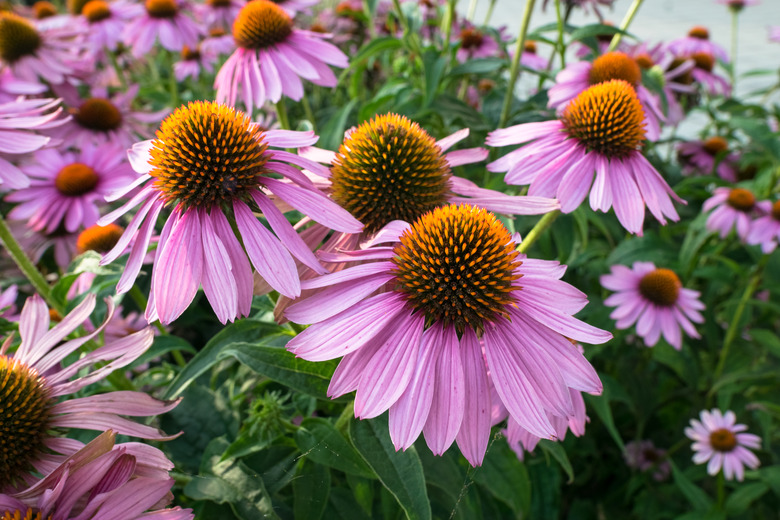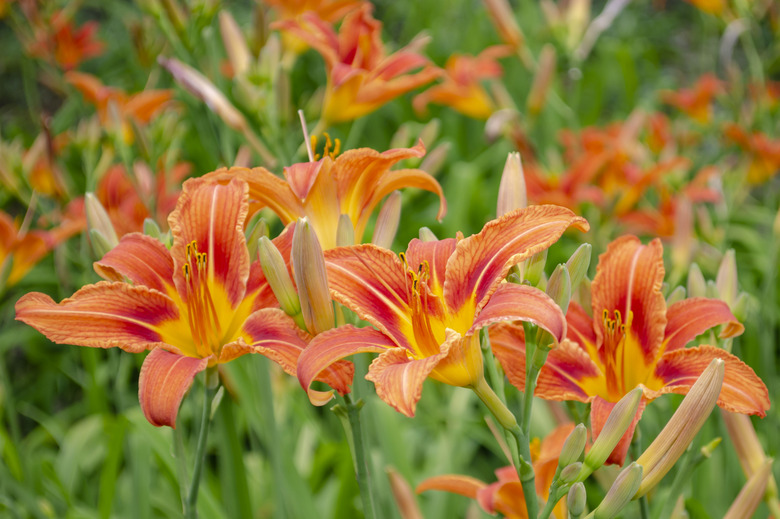7 Tips To Maximize Flower Buds And Extend Blooms
The more numerous the flower buds, the more color in your yard in the near future. To keep an abundance of buds and blooms in your landscape at any given time, choose perennials that have long-living flowers. Garden practices such as deadheading and pinching back new growth also lead to an abundance of flower buds, resulting in pops of color like extreme slow-motion fireworks for your yard.
1. Choose Long-blooming plants.
1. Choose Long-blooming plants.
The easiest way to extend the bloom time of flowers in your yard is to choose at least a few varieties known for their lengthy bloom life. Echinacea, or coneflower, is one excellent choice that's low-maintenance and actually benefits the butterflies and bees in the area, which in turn help pollinate other plants. Birds also enjoy the seeds of the coneflower once the blooms are spent at the end of the season. Echinacea blooms for most of the summer, or about two months. Perhaps the most popular of all coneflowers, the purple coneflower (Echinacea purpurea) thrives in USDA plant hardiness zones 3 to 9, as do many other coneflower varieties.
Rozanne geraniums (Geranium 'Gerwat' ROZANNE), also known as cranesbill or hardy geraniums, are perennials in USDA hardiness zones 5 to 8. These are among the longest-lasting perennial blooms, offering abundant blue to purple color from midspring through midfall on average. These spread out a few feet within one season, so they're great for borders and rock gardens as well.
The Stella de Oro reblooming daylily (Hemerocallis 'Stella de Oro', USDA zones 3-10) is another perennial favorite, as it blooms in spring and then again toward the end of summer into fall. Just be sure you've selected the reblooming type, as not all daylily varieties bloom again the same year. As the name "daylily" implies, each flower lasts for about a day, but the blooms are so abundant that the plant seems to be continually in bloom for quite some time.
2. Choose appropriate locations.
2. Choose appropriate locations.
The location you choose for your plants could affect the number and life span of the blooms on each plant. For instance, if you are growing perennials that call for six to eight hours of direct sunlight each day and you plant them in a shady location, the number of flower buds produced in one season could be far less than on the same type of plant grown just yards away in a sunny location.
If you have a dog that enjoys the yard, plant the flowers in an area well out of the dog's reach, as frequent urination in the same spot could harm or even kill your perennials. Dog urine contains components such as nitrogen and salts that do the same type of damage as pouring too much liquid fertilizer in the same spot repeatedly. These compounds could also dehydrate plant cells, which harms the plant's tissue.
3. Improve the soil.
3. Improve the soil.
The soil conditions in your flower bed also affect the number of blooms on each plant and how well the plant thrives in general. Much like people, plants need nutrients and water to thrive. Many perennials do best in soil that's neutral or slightly acidic with a pH in the 6.0 to 7.0 range. They generally prefer a well-drained soil that contains neither too much clay nor too much sand.
Till the soil about 6 inches deep and then mix a well-aged compost into the soil before planting or even in fall before the weather freezes in northern climates. This gives the compost time to break down in the soil. The end result is soil that's rich in nutrients and that has a closer to neutral pH than it previously had, whether the soil was acidic or alkaline.
After planting perennials, mulch or wood chips help keep the soil moist, creating a more favorable daily environment in general. For best results, tailor the soil to the plants you choose for it. If the grower recommends adding a specific type of fertilizer once per month, for instance, do so. It's just as important not to overfertilize, as this could also have a detrimental effect on your plants' health.
4. Fertilize for flowers.
4. Fertilize for flowers.
While an all-purpose garden fertilizer provides a well-balanced blend of nutrients for the average garden plant, fertilizers targeting bloom production have slightly adjusted nutrient ratios to help improve the chances of abundant, healthy flowers. Three major nutrients go into the average fertilizer for flowers: nitrogen (N), phosphorus (P) and potassium (K), listed on the product label in N-P-K ratios.
Nitrogen promotes tissue, leaf and plant growth and enables the plant's ability to absorb phosphorus, but too much could result in a leafy plant with few blooms. Phosphorus encourages root and flower growth, but too much can be harmful to the soil and the environment in general. Potassium improves the general vitality of the plant, making it more resistant to disease.
A liquid fertilizer that can be sprayed on foliage is easier for some plants to absorb, so look for this type in a blend designed for flowering plants. Spraying foliage is most effective at planting time and as the plant starts budding. A 5-10-10 fertilizer ratio is generally good for flowering plants. Dilute fertilizers when applying it around seedlings until the root system is established. Perennials in general benefit from fertilizing in early spring and in the middle of summer.
Fertilize spring and summer bulb-based perennials once they're visibly growing in spring. If the flowers bloom late in the season, apply more fertilizer in July. Roses appreciate fertilizers applied in May, June and July but not in autumn, as this could encourage new growth that could cause the plant to die in freezing winter conditions.
5. Stagger bloom times.
5. Stagger bloom times.
To maximize the number of flowers in bloom throughout the growing season, plan your plots with staggered bloom times, also known as succession planting. Planting some early-season perennials along with others that bloom in late spring or even summer gives you something to gaze at through the entire growing season. For example, the Rozanne geranium starts blooming in early spring to midspring, while the purple coneflower doesn't bloom until a couple months later.
Sketch your yard and garden plots with each month in mind so you'll quickly see which areas have abundant blooms at any time and which are sparse. This also helps you decide on colors for each part of the season if you wish to switch things up from spring to fall.
6. Deadhead for more flower buds.
6. Deadhead for more flower buds.
Deadheading flowers, which is the process of removing spent blooms, also makes room for certain plants to produce more flower buds. It encourages the plant to focus on growth and the creation of more blooms rather than focusing its energy on seed production, which happens if the dead blooms are left on the plant. For plants that do not produce more flowers after deadheading, removing the spent blooms keeps the plants looking tidy.
If the plant only has one flower per stem, feel free to cut the stem down to its base; otherwise, cut spent blooms just beneath their bases, which encourages more bud growth on other sprigs on the same stem. Removing dead or wilted leaves from their stems also helps the plant focus its energy on new growth, resulting in better overall plant health.
In the case of hardy geraniums such as the Rozanne, trimming most of the plant after it's done blooming helps promote new growth and possibly a second bloom. Cut the entire plant back to a few inches using sanitized garden shears; also cut away any remaining yellowed or browning leaves. Check the growing information that came with your plant to ensure you deadhead and prune it in the manner that's best for that specific plant variety.
In some cases, you may want to leave at least some of the spent blooms on the plants to provide a source of food for wildlife. The seeds of the echinacea are a favorite for goldfinches and chickadees, which visit the plants toward the end of summer through much of fall to retrieve the tasty treats in the conical seed heads. Any perennial with a seed head, if left to go to seed, results in more seeds that find their way into nearby areas of your garden. This results in additional blooms for even more color in years to come.
7. Pinch, pinch, pinch.
7. Pinch, pinch, pinch.
Pinching back the growing tips on perennials that produce numerous blooms helps the plant to become more bushy and to create even more blooms. Pinch and remove some of the small, leafy plant tips and not the flower buds on parts of the plant in late spring and early summer once you see several sets of leaves on any stem end.
The pinching process is best done on only some of the stems, as this delays the bud-producing process on the pinched stems, making the plant produce blooms for longer than it might have otherwise. Do not pinch back perennials that produce just one flower per stem or those that have just one leafy stalk, such as the iris.
References
- The Old Farmer's Almanac: Growing Coneflowers
- Monrovia: Long-Blooming Perennials for a More Beautiful Landscape
- Walters Gardens: Geranium 'Rozanne'
- Missouri Botanical Garden: Hemerocallis 'Stella de Oro'
- American Meadows: Stella D'Oro Reblooming Daylily
- Bedford Extension Master Gardeners: Finding Plants That are Tolerant to Dog Urine
- Rozanne and Friends: How to Prune Your Hardy Geraniums
- Southern Living: Pruning 101: How to Prune Annuals and Perennials
- Gardener's Supply Company: Fertilizer Basics
- University of Massachusetts Amherst: Fertilizing Flower Gardens and Avoid Too Much Phosphorus

